Tunnel boring machine
This article includes a list of general references, but it lacks sufficient corresponding inline citations. (November 2010) |

A tunnel boring machine (TBM), also known as a "mole" or a "worm", is a machine used to excavate tunnels. Tunnels are excavated through hard rock, wet or dry soil, or sand, each of which requires specialized technology.
Tunnel boring machines are an alternative to drilling and blasting (D&B) methods and "hand mining".
TBMs limit the disturbance to the surrounding ground and produce a smooth tunnel wall. This reduces the cost of lining the tunnel, and is suitable for use in urban areas. TBMs are expensive to construct, and larger ones are challenging to transport. These fixed costs become less significant for longer tunnels.
TBM-bored tunnel cross-sections range from 1 to 17.6 meters (3.3 to 57.7 ft) to date. Narrower tunnels are typically bored using trenchless construction methods or horizontal directional drilling rather than TBMs. TBM tunnels are typically circular in cross-section although they may be u-shaped, horseshoes, square or rectangular.[1][2][3][4][5][6]
Tunneling speeds increase over time. The first TBM peaked at 4 meters per week. This increased to 16 meters per week four decades later. By the end of the 19th century, speeds had reached over 30 meters per week. 21st century rock TBMs can excavate over 700 meters per week, while soil tunneling machines can exceed 200 meters per week. Speed generally declines as tunnel size increases.[7]
History
[edit]
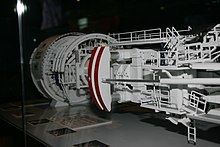
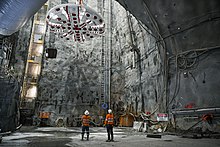
1800s
[edit]The first successful tunnelling shield was developed by Sir Marc Isambard Brunel to excavate the Thames Tunnel in 1825. However, this was only the invention of the shield concept and did not involve the construction of a complete tunnel boring machine, the digging still having to be accomplished by the then standard excavation methods.[8]
The first boring machine reported to have been built was Henri Maus's Mountain Slicer.[9][10][11][12][13] Commissioned by the King of Sardinia in 1845 to dig the Fréjus Rail Tunnel between France and Italy through the Alps, Maus had it built in 1846 in an arms factory near Turin. It consisted of more than 100 percussion drills mounted in the front of a locomotive-sized machine, mechanically power-driven from the entrance of the tunnel. The Revolutions of 1848 affected the funding, and the tunnel was not completed until 10 years later, by using less innovative and less expensive methods such as pneumatic drills.[14]
In the United States, the first boring machine to have been built was used in 1853 during the construction of the Hoosac Tunnel in northwest Massachusetts.[15] Made of cast iron, it was known as Wilson's Patented Stone-Cutting Machine, after inventor Charles Wilson.[16] It drilled 3 meters (10 ft) into the rock before breaking down (the tunnel was eventually completed more than 20 years later, and as with the Fréjus Rail Tunnel, by using less ambitious methods).[17] Wilson's machine anticipated modern TBMs in the sense that it employed cutting discs, like those of a disc harrow, which were attached to the rotating head of the machine.[18][19][20] In contrast to traditional chiseling or drilling and blasting, this innovative method of removing rock relied on simple metal wheels to apply a transient high pressure that fractured the rock.
In 1853, the American Ebenezer Talbot also patented a TBM that employed Wilson's cutting discs, although they were mounted on rotating arms, which in turn were mounted on a rotating plate.[21] In the 1870s, John D. Brunton of England built a machine employing cutting discs that were mounted eccentrically on rotating plates, which in turn were mounted eccentrically on a rotating plate, so that the cutting discs would travel over almost all of the rock face that was to be removed.[22][23]
The first TBM that tunneled a substantial distance was invented in 1863 and improved in 1875 by British Army officer Major Frederick Edward Blackett Beaumont (1833–1895); Beaumont's machine was further improved in 1880 by British Army officer Major Thomas English (1843–1935).[24][25][26][27][28] In 1875, the French National Assembly approved the construction of a tunnel under the English Channel and the British Parliament supported a trial run using English's TBM. Its cutting head consisted of a conical drill bit behind which were a pair of opposing arms on which were mounted cutting discs. From June 1882 to March 1883, the machine tunneled, through chalk, a total of 1,840 m (6,036 ft).[13] A French engineer, Alexandre Lavalley, who was also a Suez Canal contractor, used a similar machine to drill 1,669 m (5,476 ft) from Sangatte on the French side.[29] However, despite this success, the cross-Channel tunnel project was abandoned in 1883 after the British military raised fears that the tunnel might be used as an invasion route.[13][30] Nevertheless, in 1883, this TBM was used to bore a railway ventilation tunnel — 2 m (7 ft) in diameter and 2.06 km (6,750 ft) long — between Birkenhead and Liverpool, England, through sandstone under the Mersey River.[31]
The Hudson River Tunnel was constructed from 1889 to 1904 using a Greathead shield TBM. The project used air compressed to 2.4 bar (35 psi) to reduce cave-ins. However, many workers died via cave-in or decompression sickness.[32][33][7]
1900s
[edit]During the late 19th and early 20th century, inventors continued to design, build, and test TBMs for tunnels for railroads, subways, sewers, water supplies, etc. TBMs employing rotating arrays of drills or hammers were patented.[34] TBMs that resembled giant hole saws were proposed.[35] Other TBMs consisted of a rotating drum with metal tines on its outer surface,[36] or a rotating circular plate covered with teeth,[37] or revolving belts covered with metal teeth.[38] However, these TBMs proved expensive, cumbersome, and unable to excavate hard rock; interest in TBMs therefore declined. Nevertheless, TBM development continued in potash and coal mines, where the rock was softer.[39]
A TBM with a bore diameter of 14.4 m (47 ft 3 in) was manufactured by The Robbins Company for Canada's Niagara Tunnel Project. The machine was used to bore a hydroelectric tunnel beneath Niagara Falls. The machine was named "Big Becky" in reference to the Sir Adam Beck hydroelectric dams to which it tunnelled to provide an additional hydroelectric tunnel.
2000s
[edit]
An earth pressure balance TBM known as Bertha with a bore diameter of 17.45 meters (57.3 ft) was produced by Hitachi Zosen Corporation in 2013.[40] It was delivered to Seattle, Washington, for its Highway 99 tunnel project.[41] The machine began operating in July 2013, but stalled in December 2013 and required substantial repairs that halted the machine until January 2016.[42] Bertha completed boring the tunnel on April 4, 2017.[43]
Two TBMs supplied by CREG excavated two tunnels for Kuala Lumpur's Rapid Transit with a boring diameter of 6.67 m (21.9 ft). The medium was water saturated sandy mudstone, schistose mudstone, highly weathered mudstone as well as alluvium. It achieved a maximum advance rate of more than 345 m (1,132 ft) per month.[44]
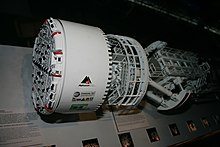
The world's largest hard rock TBM, known as Martina, was built by Herrenknecht AG. Its excavation diameter was 15.62 m (51.2 ft), total length 130 m (430 ft); excavation area of 192 m2 (2,070 sq ft), thrust value 39,485 t, total weight 4,500 tons, total installed capacity 18 MW. Its yearly energy consumption was about 62 GWh. It is owned and operated by the Italian construction company Toto S.p.A. Costruzioni Generali (Toto Group) for the Sparvo gallery of the Italian Motorway Pass A1 ("Variante di Valico A1"), near Florence. The same company built the world's largest-diameter slurry TBM, excavation diameter of 17.6 meters (58 ft), owned and operated by the French construction company Dragages Hong Kong (Bouygues' subsidiary) for the Tuen Mun Chek Lap Kok link in Hong Kong.
Types
[edit]
TBMs typically consist of a rotating cutting wheel in front, called a cutter head, followed by a main bearing, a thrust system, a system to remove excavated material (muck), and support mechanisms. Machines vary with site geology, amount of ground water present, and other factors.
Rock boring machines differ from earth boring machines in the way they cut the tunnel, the way they provide traction to support the boring activity, and in the way they support the newly formed tunnels walls.
Tunnel wall types
[edit]Concrete lining
[edit]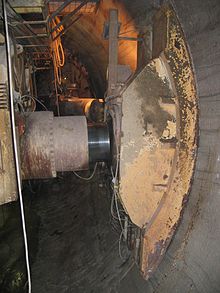
Shielded TBMs are typically used to excavate tunnels in soil. They erect concrete segments behind the TBM to support the tunnel walls.[45]
The machine stabilizes itself in the tunnel with hydraulic cylinders that press against the shield, allowing the TBM to apply pressure at the tunnel face.
Main Beam
[edit]Main Beam machines do not install concrete segments behind the cutter head. Instead, the rock is held up using ground support methods such as ring beams, rock bolts, shotcrete, steel straps, ring steel and wire mesh.[45]
Shield types
[edit]Depending on the stability of the local geology, the newly formed walls of the tunnel often need to be supported immediately after being dug to avoid collapse, before any permanent support or lining has been constructed. Many TBMs are equipped with one or more cylindrical shields following behind the cutter head to support the walls until permanent tunnel support is constructed further along the machine. The stability of the walls also influences the method by which the TBM anchors itself in place so that it can apply force to the cutting head. This in turn determines whether the machine can bore and advance simultaneously, or whether these are done in alternating modes.
Open/Gripper
[edit]Gripper TBMs are used in rock tunnels. They forgo the use of a shield and instead push directly against the unreinforced sides of the tunnel.[7]
Machines such as a Wirth machine can be moved only while ungripped. Other machines can move continuously. At the end of a Wirth boring cycle, legs drop to the ground, the grippers are retracted, and the machine advances. The grippers then reengage and the rear legs lift for the next cycle.
Single shield
[edit]A single-shield TBM has a single cylindrical shield after the cutting head. A permanent concrete lining is constructed immediately after the shield, and the TBM pushes off the lining to apply force to the cutter head. Because this pushing cannot be done while a next ring of lining is being constructed, the single-shield TBM operates in alternating cutting and lining modes.
Double shield
[edit]Double Shield (or telescopic shield) TBMs have a leading shield that advances with the cutting head and a trailing shield that acts as a gripper. The two shields can move axially relative to each other (i.e., telescopically) over a limited distance. The gripper shield anchors the TBM so that pressure can be applied to the cutter head while simultaneously the concrete lining is being constructed.
Tunnel-face support methods
[edit]In hard rock with minimal ground water, the area around the cutter head of a TBM can be unpressurized, as the exposed rock face can support itself. In weaker soil, or when there is significant ground water, pressure must be applied to the face of the tunnel to prevent collapse and/or the infiltration of ground water into the machine.
Earth Pressure Balance
[edit]
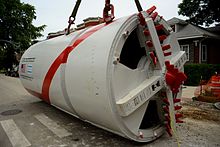
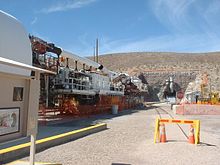
Earth pressure balance (EPB) machines are used in soft ground with less than 7 bar (100 psi) of pressure. It uses muck to maintain pressure at the tunnel face. The muck (or spoil) is admitted into the TBM via a screw conveyor. By adjusting the rate of extraction of muck and the advance rate of the TBM, the pressure at the face of the TBM can be controlled without the use of slurry. Additives such as bentonite, polymers and foam can be injected ahead of the face to stabilize the ground. Such additives can separately be injected in the cutter head and extraction screw to ensure that the muck is sufficiently cohesive to maintain pressure and restrict water flow.
Like some other TBM types, EPB's use thrust cylinders to advance by pushing against concrete segments. The cutter head uses a combination of tungsten carbide cutting bits, carbide disc cutters, drag picks and/or hard rock disc cutters.
EPB has allowed soft, wet, or unstable ground to be tunneled with a speed and safety not previously possible. The Channel Tunnel, the Thames Water Ring Main, sections of the London Underground, and most new metro tunnels completed in the last 20 years worldwide were excavated using this method. EPB has historically competed with the slurry shield method (see below), where the slurry is used to stabilize the tunnel face and transport spoil to the surface. EPB TBMs are mostly used in finer ground (such as clay) while slurry TBMs are mostly used for coarser ground (such as gravel).[46]
Slurry shield
[edit]Slurry shield machines can be used in soft ground with high water pressure or where granular ground conditions (sands and gravels) do not allow a plug to form in the screw. The cutter head is filled with pressurised slurry, typically made of bentonite clay that applies hydrostatic pressure to the face. The slurry mixes with the muck before it is pumped to a slurry separation plant, usually outside the tunnel.
Slurry separation plants use multi-stage filtration systems that separate spoil from slurry to allow reuse. The degree to which slurry can be 'cleaned' depends on the relative particle sizes of the muck. Slurry TBMs are not suitable for silts and clays as the particle sizes of the spoil are less than that of the bentonite. In this case, water is removed from the slurry leaving a clay cake, which may be polluted.
A caisson system is sometimes placed at the cutting head to allow workers to operate the machine,[47][48] although air pressure may reach elevated levels in the caisson, requiring workers to be medically cleared as "fit to dive" and able to operate pressure locks.[47][48]
Open face soft ground
[edit]Open face soft ground TBMs rely on the excavated ground to briefly stand without support. They are suitable for use in ground with a strength of up to about 10 MPa (1,500 psi) with low water inflows. They can bore tunnels with cross-section in excess of 10 m (30 ft). A backactor arm or cutter head bore to within 150 mm (6 in) of the edge of the shield. After a boring cycle, the shield is jacked forward to begin a new cycle. Ground support is provided by precast concrete, or occasionally spheroidal graphite iron (SGI) segments that are bolted or supported until a support ring has been added. The final segment, called the key, is wedge-shaped, and expands the ring until it is tight against the ground.
Tunnel size
[edit]TBMs range diameter from 1 to 17 meters (3 to 56 ft). Micro tunnel shield TBMs are used to construct small tunnels, and is a smaller equivalent to a general tunnelling shield and generally bore tunnels of 1 to 1.5 meters (3.3 to 4.9 ft), too small for operators to walk in.
Backup systems
[edit]Behind all types of tunnel boring machines, in the finished part of the tunnel, are trailing support decks known as the backup system, whose mechanisms can include conveyors or other systems for muck removal; slurry pipelines (if applicable); control rooms; electrical, dust-removal and ventilation systems; and mechanisms for transport of pre-cast segments.
Urban tunnelling and near-surface tunnelling
[edit]Urban tunnelling has the special requirement that the surface remain undisturbed, and that ground subsidence be avoided. The normal method of doing this in soft ground is to maintain soil pressures during and after construction.
TBMs with positive face control, such as earth pressure balance (EPB) and slurry shield (SS), are used in such situations. Both types (EPB and SS) are capable of reducing the risk of surface subsidence and voids if ground conditions are well documented. When tunnelling in urban environments, other tunnels, existing utility lines and deep foundations must be considered, and the project must accommodate measures to mitigate any detrimental effects to other infrastructure.[citation needed]
See also
[edit]- Channel Tunnel – Undersea rail tunnel linking France to UK
- New Austrian tunneling method – Method of modern tunnel design and construction
- Roadheader – Excavation equipment
- Subterrene – Vehicle that moves through solid rock or soil
- Trenchless technology – Underground construction that minimizes surface disruption
Notes
[edit]- ^ ""U-shape": First Shield Machine for horseshoe-shaped Cross Sections - tunnel". www.tunnel-online.info. Archived from the original on 2020-02-27. Retrieved 2020-02-27.
- ^ "Special Application TBM U-Shape TBM". CREG Underground Solutions. Archived from the original on 9 September 2017. Retrieved 2 November 2021.
- ^ "Special Shield Machine | Kawasaki Heavy Industries". global.kawasaki.com. Archived from the original on 2021-09-26. Retrieved 2021-10-02.
- ^ Tan, Christopher (June 14, 2016). "New tunnel-boring machine makes cutting corners perfectly sound". The Straits Times. Archived from the original on February 27, 2020. Retrieved February 27, 2020.
- ^ "Shield Machines and Tunnel Boring Machines (TBMs) - Construction, Mining and Utility Equipment|Products & Services|Komatsu Ltd". Komatsu Ltd. Archived from the original on 2023-07-28. Retrieved 2021-10-02.
- ^ "Tunnel Boring Machines (Shield and TBM)" (PDF). global.kawasaki.com. Kawasaki. Archived (PDF) from the original on 1 October 2021. Retrieved 2 November 2021.
- ^ a b c Potter 2023.
- ^ Bagust 2006, p. 65.
- ^ Drinker 1883, pp. 191-194.
- ^ Bancroft 1908, p. 58.
- ^ West 1988.
- ^ Maidl et al. 2008.
- ^ a b c Hemphill 2013.
- ^ Hapgood, Fred, "The Underground Cutting Edge: The innovators who made digging tunnels high-tech",Invention & Technology Vol.20, #2, Fall 2004 Archived 2005-03-15 at the Wayback Machine
- ^ Maidl et al. 2008, p. 1.
- ^ Smith, Gary. "FINDING AID FOR THE HOOSAC TUNNEL COLLECTION at the NORTH ADAMS PUBLIC LIBRARY". Hooac Tunnel Historical Notes. North Adams Public Library. Archived from the original on 15 January 2004. Retrieved 14 July 2011.
- ^ Howes, M. "Hoosac Tunnel History - Abridged Timeline". Archived from the original on 21 May 2011. Retrieved 14 July 2011.
- ^ Bancroft 1908, p. 65.
- ^ Charles Wilson, "Dressing stone," U.S. patent 5,012 (issued: March 13, 1847).
- ^ Charles Wilson, "Machine for tunneling rocks, etc.," U.S. patent 14,483 (issued: March 18, 1856).
- ^ Ebenezer Talbot, "Machine for tunnelling or boring rock," U.S. patent 9,774 (issued: June 7, 1853).
- ^ West 1988, pp. 239–242.
- ^ John D. Brunton, "Improved machine for sinking shafts," U.S. patent 80,056 (issued: July 21, 1868).
- ^ West 1988, pp. 243–247.
- ^ David William Brunton and John Allen Davis, Modern Tunneling: With Special Reference to Mine and Water-supply Tunnels (New York, New York: John Wiley & Sons, 1914), p. 182.
- ^ Frederick Edward Blackett Beaumont, U.K. Patent no. 1,904 (issued: July 30, 1864). (See: Patents for Inventions. Abridgments of Specifications relating to Mining, Quarrying, Tunnelling, and Well-sinking (London, England: Office of the Commissioners of Patents for Inventions, 1874), p. 247. Archived 2023-07-28 at the Wayback Machine)
- ^ F.E.B. Beaumont, U.K. Patent no. 4,166 (issued: Dec. 2, 1875). (See: Patents for Inventions. Abridgments of Specifications. Class 85, Mining, Quarrying, Tunnelling, and Well-sinking (London, England: Patent Office, 1904), p. 169. Archived 2023-07-28 at the Wayback Machine)
- ^ Thomas English, U.K. Patent no.s 4,347 (issued: October 25, 1880) and 5,317 (issued: December 5, 1881); "Tunneling-machine," U.S. patent 307,278 (filed: June 4, 1884 ; issued: October 28, 1884).
- ^ Wilson, Jeremy; Spick, Jérôme (1994). Eurotunnel: The Illustrated Journey. New York, NY, USA: Harper Collins. pp. 14–21. ISBN 0-00-255539-5.
- ^ Terry Gourvish, The Official History of Britain and the Channel Tunnel (Abington, England: Routledge, 2006), Chapter 1, § 2: The commercial possibilities: Lord Richard Grosvenor, Sir Edward Watkin and the 'Manchester to Paris Railroad'.
- ^ West 1988, p. 248.
- ^ American Society of Civil Engineers. "Hudson and Manhattan Railroad Tunnel". www.asce.org. Retrieved 2023-10-17.
- ^ "ASCE Metropolitan Section - Hudson & Manhattan Tunnel". www.ascemetsection.org. Retrieved 2023-10-17.
- ^ See:
- Bancroft 1908, pp. 66, 125, 127, 146
- Thales Lindsey, "Improved machine for tunneling rock," U.S. patent 55,514 (issued: June 12, 1866).
- Pedro Unanue, "Tunneling machine," U.S. patent 732,326 (filed: December 23, 1901; issued: June 30, 1903).
- Russell B. Sigafoos, "Rotary tunneling machine," U.S. patent 901,392 (filed: May 18, 1907; issued: October 20, 1908).
- George A. Fowler, "Tunnel driving machine," U.S. patent 891,473 (filed: July 30, 1907 ; issued: June 23, 1908).
- ^ See:
- Bancroft 1908, pp. 66, 85, 106
- Charles Wilson, Machine for excavating tunnels," U.S. patent 17,650 (issued: June 23, 1857).
- Reginald Stanley, U.K. Patent no. 1,449 (issued: February 1, 1886); "Tunneling-machine" (issued: August 7, 1894).
- Jonas L. Mitchell, "Tunneling-machine," U.S. patent 537,899 (filed: April 3, 1893 ; issued: April 23, 1895).
- ^ See:
- William F. Cooke and George Hunter, U.K. patent no. 433 (issued: August 10, 1866). Available online at: AditNow Archived 2016-03-04 at the Wayback Machine.
- Patents for Inventions. bridgments of Specifications relating to Mining, Quarrying, Tunnelling, and Well-sinking (London, England: Office of the Commissioners of Patents for Inventions, 1874), p. 275. Archived 2023-07-28 at the Wayback Machine
- Maidl et al. 2008
- ^ See:
- Bancroft 1908, pp. 146, 165
- John P. Karns, "Tunneling-machine," U.S. patent 848,107 (filed: November 29, 1905; issued: March 26, 1907).
- Olin S. Proctor, "Tunneling-machine," U.S. patent 900,951 (filed: February 17, 1908; issued: October 13, 1908).
- ^ See:
- Bancroft 1908, p. 145
- William A. Lathrop, "Machine for cutting headings," U.S. patent 816,923 (filed: August 31, 1903; issued: April 3, 1906).
- ^ For example:
- In Germany, the Eisener Bergmann (iron miner) was developed in 1916 by Schmidt, Kranz & Co. for potash mines; its boring head consisted of a large rotating roller that was fitted with cutters See: Maidl et al. 2008
- In the U.S., the McKinlay Entry Driver, a track-mounted TBM or "continuous miner", was invented in 1918 for use in coal mines. Its boring head consisted of metal tines on two, side-by-side rotating arms. See: Thomas W. Garges (November 13, 2003) William N. Poundstone lecture: "Underground Mining Technology Evolution", p. 8. Available online at: Benjamin M. Statler College of Engineering and Mineral Resources, West Virginia University Archived 2016-10-20 at the Wayback Machine
- ^ "Shield Tunneling Machines". Hitachi Zosen Corporation. Archived from the original on 2023-01-23. Retrieved 2023-02-04.
- ^ "Alaskan Way Viaduct - Home". www.wsdot.wa.gov. Archived from the original on 28 July 2023. Retrieved 21 July 2017.
- ^ Weise, Karen. "Bertha the giant drill is ready to rumble in Seattle". Bloomberg Businessweek. Archived from the original on 2016-03-09. Retrieved 21 July 2017 – via www.bloomberg.com.
- ^ "Alaskan Way Viaduct - Recapping Bertha's breakthrough". Washington State Department of Transportation. 2017-04-06. Archived from the original on 2017-09-01.
- ^ "CREG | EPB". www.creg-germany.com. Metro Kuala Lumpur, Malaysia > Tech Specs. Archived from the original on 2017-09-09. Retrieved 2020-11-03.
- ^ a b Stack 1995.
- ^ Shen, Si (25 October 2021). "TBM selection - EPB and SlurrySi Shen". The Si-Eng. Retrieved 2023-10-29.
- ^ a b Walters, D. "Sydney Airport Link Rail Tunnel Project, Des Walters: Under Pressure Underground". Descend Underwater Training Centre. Archived from the original on 2003-09-24. Retrieved 2008-10-08.
- ^ a b Bennett, MH; Lehm, J; Barr, P. "Medical support for the Sydney Airport Link Tunnel project". South Pacific Underwater Medicine Society. 32 (2). Archived from the original on December 11, 2008. Retrieved 2008-10-08.
References
[edit]- Bagust, Harold (2006). The greater genius?: a biography of Marc Isambard Brunel. Ian Allan Publishing. ISBN 0-7110-3175-4.
- Bancroft, George J. (1908) "A history of the tunnel boring machine," Mining Science, p. 58, 65-68, 85–88, 106–108, 125–127, 145–146, 165-167
- Drinker, Henry Sturgis. Treatise on Explosive Compounds, Machine Rock Drills and Blasting (New York, New York: J. Wiley & Sons, 1883), pp. 191-194.
- Hemphill, Gary B. Practical Tunnel Construction (Hoboken, New Jersey: John Wiley & Sons, 2013), Chapter 7: Tunnel-boring machines: History of tunnel-boring machine.
- Maidl, Bernhard; Schmid, Leonhard; Ritz, Willy; Herrenknecht, Martin (2008). Hardrock Tunnel Boring Machines. Ernst & Sohn. ISBN 978-3-433-01676-3.
- Potter, Brian (6 October 2023). "The Evolution of Tunnel Boring Machines". www.construction-physics.com. Retrieved 2023-10-08.
- Stack, Barbara, "Encyclopaedia of Tunnelling, Mining, and Drilling Equipment", 1995.
- West, Graham. Innovation and the Rise of the Tunnelling Industry (Cambridge, England: Cambridge University Press, 1988), Chapter 11: Hard rock tunnelling machines.
Further reading
[edit]- Barton, Nick (2000). TBM tunnelling in jointed and faulted rock. Rotterdam: Balkema.
- Bilger, Burkhard (September 15, 2008). "The Long Dig: Getting through the Swiss Alps the hard way". The New Yorker.
- Foley, Amanda (May 2009). "Life on the Cutting Edge: Dick Robbins". Tunnels & Tunnelling International.
External links
[edit]- Robbins. "Tunneling World Records". Robbins. Retrieved 2023-10-18.
